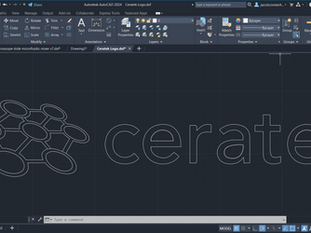

We offer process development in Photopolymer formulation, antireflection coatings, edge and grayscale mask development for microfluidics, 3D DLP microprinting and much more!

Advanced Photolithography Techniques: DUV Lithography, Spin-coating, Direct Write UV Lithography
Introduction to Lithography
Understanding Lithography Principles
Lithography is a crucial process in the field of nanofabrication and semiconductor manufacturing. It involves transferring patterns onto a substrate, typically using light or electron beams. Advanced lithography techniques such as DUV lithography, spin-coating, and direct-write UV lithography have revolutionized the industry by enabling higher precision and efficiency in pattern transfer.
Applications of Advanced Lithography Techniques
The applications of advanced lithography techniques are vast and varied. They are used in the production of integrated circuits, microelectromechanical systems (MEMS), nanotechnology devices, and more. These techniques play a critical role in pushing the boundaries of what is possible in modern technology.
DUV Lithography: Pushing the Boundaries
DUV lithography, or deep ultraviolet lithography, is a cutting-edge technique that utilizes shorter wavelengths of light to achieve higher resolution and finer features. This method has significantly advanced the semiconductor industry by allowing for the production of smaller and more complex devices.
Ceratek utilizes state of the art Excimer lasers capable of 248nm KrF, and 193nm ArF with optics changes.
Principles of DUV Lithography
The principles of DUV lithography revolve around the use of short-wavelength light sources, typically in the deep ultraviolet range. This enables the creation of intricate patterns with nanoscale precision, making it a preferred choice for high-density semiconductor manufacturing.
Advancements in DUV Lithography
Recent advancements in DUV lithography have focused on enhancing multi-patterning techniques and developing innovative resist and mask materials. These improvements have further pushed the limits of what can be achieved in terms of feature size and complexity.
Multi-Patterning Techniques
Multi-patterning techniques involve splitting a single pattern into multiple exposures to achieve higher resolution. This approach is essential for creating intricate designs that exceed the limits of conventional lithography methods.
Resist and Mask Innovations
Ongoing research in resist and mask materials has led to the development of new formulations that are more resistant to radiation and offer improved resolution. These innovations are critical for advancing DUV lithography capabilities.
Spin-coating: Precision Thin Film Deposition
Spin-coating is a technique used for depositing uniform thin films onto substrates. By spinning the substrate at high speeds while dispensing a liquid precursor, a thin and even film can be achieved. This method is widely employed in nanofabrication processes due to its precision and reproducibility.
Ceratek Utilizes state of the art Brewer Science spin coating systems
Fundamentals of Spin-coating
The fundamental principle of spin-coating involves the creation of a centrifugal force that spreads the liquid precursor across the substrate surface. The speed of rotation and viscosity of the precursor determine the thickness and uniformity of the resulting film.
Applications in Nanofabrication
Spin-coating is commonly used in the fabrication of thin films, photoresists, and other nanostructures. Its ability to produce uniform coatings with controlled thickness makes it an essential technique in various industries, including microelectronics, optics, and biotechnology.
Direct Write UV Lithography: Flexibility and Accuracy
Direct write UV lithography offers unparalleled flexibility and accuracy in creating custom patterns and designs. This technique eliminates the need for masks, allowing for rapid prototyping and quick design iterations.
Principle and Mechanism of Direct Write UV Lithography
Direct write UV lithography operates by directly exposing the photoresist to a focused UV beam, enabling precise pattern generation. This method is ideal for low-volume production and research applications where customization and speed are paramount.
We utilize our own custom built 355nm UV vanadate laser systems for direct write lithography on both negative and positive tone photopolymers. Direct Write lithography allows us to rapid prototype lithography patterns and to create custom photomasks for our DUV image projection systems. We utilize both Texas instruments DLP light engines for spatial light modulation of both Black & White exposures (405-355nm) and Galvanometer scanning systems (355nm). Each have their own advantages and drawbacks with regard to speed, field of view and minimum critical dimension size.
Advantages and Limitations
The advantages of direct write UV lithography include rapid prototyping, high resolution, and design flexibility. However, this technique may have limitations in scalability and throughput compared to traditional lithography methods.
Direct Write lithography goes hand-in-hand with DUV image projection lithography and we utilize both methods efficiently. Typically leveraging the direct write system to develop and prototype a proof of concept design, and then to write the chrome on quartz masks for our DUV projection systems for high volume production.
Challenges and Future Perspectives
Despite the significant advancements in lithography techniques, challenges remain in achieving even higher resolution, reducing production costs, and improving process efficiency. Future perspectives in lithography research include exploring new materials, enhancing equipment capabilities, and integrating artificial intelligence for process optimization.
While the up-front costs are typically high, the technique allows for mass production of many devices at a much faster rate and much higher accuracy than serial laser micromachining.
Much of the challenges lie in the iterative process of developing masks, testing the design, making changes to patterns (adding serifs for example, to compensate over or under etching) and repeating the process until the desired pattern is created on the substrate. Subsequent process steps may include additive processes like thin film deposition, or subtractive such as wet chemical etching, DRIE, or RIE etching.
Call Ceratek today to discuss your application needs.




